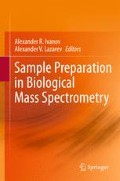Abstract
This chapter discusses the use of alternating hydrostatic pressure (Pressure Cycling Technology, or PCT) and optimized solvents for detergent-free disruption of white adipose tissue samples for proteomic analyses. This technique can increase efficiency of protein recovery from mouse fat tissue specimens as compared to conventional homogenization and dissolution techniques. Protein extracts generated using PCT were analyzed by SDS-PAGE, 2D-electrophoresis, and nanoflow HPLC coupled to high resolution, high mass accuracy tandem mass spectrometry. As a result, a novel pressure cycling-assisted liquid-liquid extraction and fractionation method has been developed to achieve nearly complete tissue dissolution and fractionation of lipids and proteins into distinct liquid phases. This method allows for efficient extraction of highly hydrophobic proteins typically underrepresented in the extracts obtained using conventional methods. A pilot analysis of several genetically distinct model mouse lines and diets has revealed trends in protein expression which may be linked to obesity and metabolic syndrome progression, or also serve as potential drug targets. Proteomic analysis using 2D-gels and 1D-gel LC MS/MS revealed greater representation of proteins involved in lipid, glucose, and energy metabolism, as well as acute phase response and oxidative stress response signaling pathways linked to obesity. The pilot results of comparative proteomic analyses of adipose tissue harvested from animals of different genotypes and exposed to different diets were analyzed further using gene ontology and functional pathway analysis bioinformatics tools. Lipid fractions obtained from the tissue samples using the newly developed sample preparation and fractionation platform were collected for future lipid mass spectrometry-based profiling studies.
Access this chapter
Tax calculation will be finalised at checkout
Purchases are for personal use only
References
Andreev, V.P., Dwivedi, R.C., Paz-Filho, G., Krokhin, O.V., Wong, M.L., Wilkins, J.A., and Licinio, J. (2007). Dynamics of plasma proteome during leptin-replacement therapy in genetically based leptin deficiency. Pharmacogenomics J 7, 666–685.
Cinti, S. (2005). The adipose organ. Prostaglandins Leukot Essent Fatty Acids 73, 9–15.
Curtis, J.M., Grimsrud, P.A., Wright, W.S., Xu, X., Foncea, R.E., Graham, D.W., Brestoff, J.R., Wiczer, B.M., Ilkayeva, O., Cianflone, K., et al. (2010). Downregulation of adipose glutathione S-transferase A4 leads to increased protein carbonylation, oxidative stress, and mitochondrial dysfunction. Diabetes 59, 1132–1142.
Freeman, E., and Ivanov, A.R. (2010). Proteomics Under Pressure: Development of Essential Sample Preparation Techniques in Proteomics Using Ultra-high Hydrostatic Pressure (Boston, MA, Harvard School of Public Health).
Freeman, E., Margolin, Y., and Ivanov, A.R. (2009). Searching for efficient and high-throughput alternatives for essential sample preparation techniques in mass-spectrometry-based functional proteomics. In ABRF (Memphis, TN).
Furukawa, S., Fujita, T., Shimabukuro, M., Iwaki, M., Yamada, Y., Nakajima, Y., Nakayama, O., Makishima, M., Matsuda, M., and Shimomura, I. (2004). Increased oxidative stress in obesity and its impact on metabolic syndrome. J Clin Invest 114, 1752–1761.
Gnacinska, M., Malgorzewicz, S., Stojek, M., Lysiak-Szydlowska, W., and Sworczak, K. (2009). Role of adipokines in complications related to obesity: A review. Adv Med Sci 54, 150–157.
Gross, V., Carlson, G., Kwan, A.T., Smejkal, G., Freeman, E., Ivanov, A.R., and Lazarev, A. (2008). Tissue fractionation by hydrostatic pressure cycling technology: The unified sample preparation technique for systems biology studies. J Biomol Tech 19, 189–199.
Kershaw, E.E., and Flier, J.S. (2004). Adipose tissue as an endocrine organ. J Clin Endocrinol Metab 89, 2548–2556.
Lanne, B., Potthast, F., Hoglund, A., Brockenhuus von Lowenhielm, H., Nystrom, A.C., Nilsson, F., and Dahllof, B. (2001). Thiourea enhances mapping of the proteome from murine white adipose tissue. Proteomics 1, 819–828.
Lindstrom, P. (2007). The physiology of obese-hyperglycemic mice [ob/ob mice]. Sci World J 7, 666–685.
Schmidt, M.W., Houseman, A., Ivanov, A.R., and Wolf, D.A. (2007). Comparative proteomic and transcriptomic profiling of the fission yeast schizosaccharomyces pombe. Mol Syst Biol 3, 79.
Spalding, K.L., Arner, E., Westermark, P.O., Bernard, S., Buchholz, B.A., Bergmann, O., Blomqvist, L., Hoffstedt, J., Naslund, E., Britton, T., et al. (2008). Dynamics of fat cell turnover in humans. Nature 453, 783–787.
Trayhurn, P. (2005). Endocrine and signalling role of adipose tissue: New perspectives on fat. Acta Physiol Scand 184, 285–293.
Trayhurn, P., and Wood, I.S. (2004). Adipokines: Inflammation and the pleiotropic role of white adipose tissue. Br J Nutr 92, 347–355.
Trayhurn, P., and Wood, I.S. (2005). Signalling role of adipose tissue: Adipokines and inflammation in obesity. Biochem Soc Trans 33, 1078–1081.
Washburn, M.P., Ulaszek, R., Deciu, C., Schieltz, D.M., and Yates, J.R., 3rd. (2002). Analysis of quantitative proteomic data generated via multidimensional protein identification technology. Anal Chem 74, 1650–1657.
Acknowledgements
We would like to thank Pressure Biosciences and Drs. Haiming Cao and Gökhan Hotamisligil for providing pilot fat adipose tissue samples. We are thankful for the financial support of the Department of Genetics and Complex Diseases at the Harvard School of Public Health.
Author information
Authors and Affiliations
Corresponding author
Editor information
Editors and Affiliations
Rights and permissions
Copyright information
© 2011 Springer Science+Business Media B.V.
About this chapter
Cite this chapter
Freeman, E.A., Gross, V., Romanovsky, I., Lazarev, A.V., Ivanov, A.R. (2011). Adipose Tissue Lysis and Protein Extraction Followed by MS-based Proteomic Profiling Reveals Constituents of Oxidative Stress in Obesity. In: Ivanov, A., Lazarev, A. (eds) Sample Preparation in Biological Mass Spectrometry. Springer, Dordrecht. https://doi.org/10.1007/978-94-007-0828-0_30
Download citation
DOI: https://doi.org/10.1007/978-94-007-0828-0_30
Published:
Publisher Name: Springer, Dordrecht
Print ISBN: 978-94-007-0758-0
Online ISBN: 978-94-007-0828-0
eBook Packages: Chemistry and Materials ScienceChemistry and Material Science (R0)

